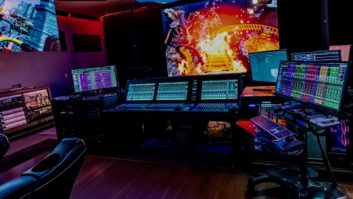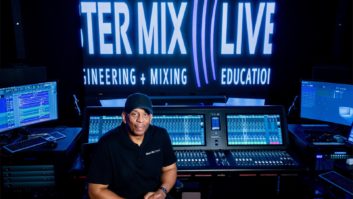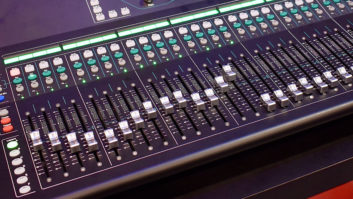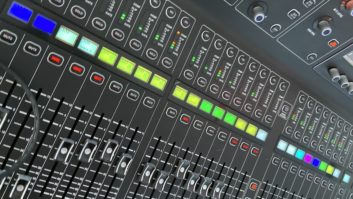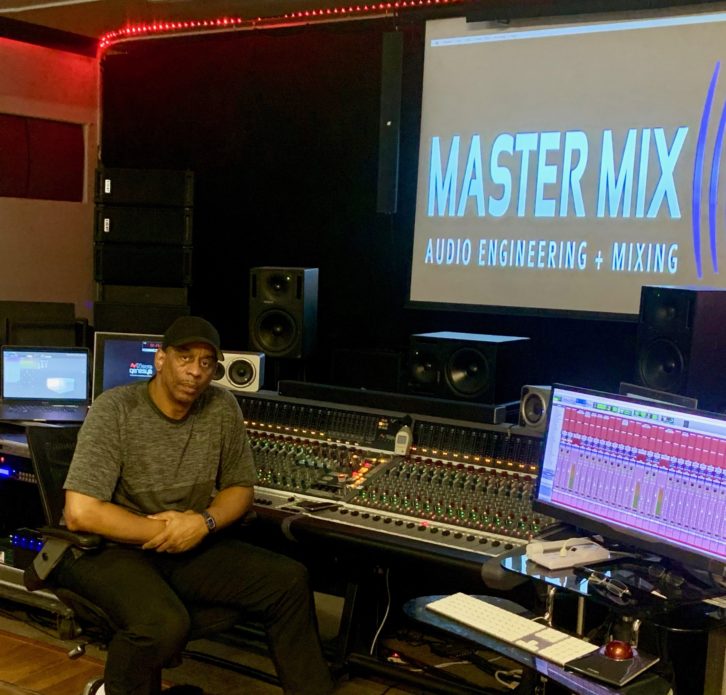
When Rick Camp conducted a test earlier this year with German networking and bridging solutions developer DirectOut Technologies to stream multitrack audio across 5,800 miles using standard Internet connections in real time, the results were impressive. The average time taken to transport 48 tracks of uncompressed 48kHz, 24-bit audio from a studio in Milan, Italy, to Camp’s Master Mix Live Studio in Las Vegas was roughly 100 milliseconds, or 500 samples.
That’s too much latency for musicians to collaborate remotely, of course, but that wasn’t what Camp was hoping to achieve. “I said, ‘I want to be able to mix somebody’s show from my studio in real time.’ They said, ‘No problem.’”
For 35 years Camp has pursued a dual career, working in the studio between touring as a front-of-house mixer for some major marquee names: Beyoncé, Madonna, Jennifer Lopez. An accomplished trumpet and trombone player who attended Berklee College of Music back in the day, he found his true calling in the studios and clubs of his native Ohio. In 1988 he hooked up with The Whispers, moved to L.A. and got his first taste of world travel, touring with the band for 12 years. In 1993 he set up Reel Tyme Productions & Recording after buying a house and studio from The Commodores’ Walter Orange, with whom he had been working for a while.
The latest chapter in Camp’s life began in 2003. “I was on tour with Beyoncé, and our final show was the Radio Music Awards in Vegas at the Aladdin. That’s where I met my wife; she was an actress and a stand-in reading lines for Beyoncé. That day I met her was her birthday. Three days later was my birthday. And we have been together ever since.”
Camp relocated to Las Vegas and eventually set about rebuilding his studio. He had previously donated a mixing console, 2-inch tape machine and effects rack to a youth center when studio business everywhere started to taper off. But the youth center had since lost its lease. “A friend of mine was teaching there. I said, ‘What did you do with my gear?’ He said, ‘They’re selling it.’ I said, ‘Give me my stuff back!”
The console, a Sony DMX-R100, had already been sold, but he got his Otari machine and effects rack back. As luck would have it, he didn’t need a desk. Years before, Camp had flown out to install a Neve Genesys at Orange’s new studio in Florida, but it proved to be too much console for him. A few years later, he called Camp to swap it out for a PreSonus Live board.
“We packed the Genesys up and put it upstairs, where it stayed for two years,” Camp says. “When I was starting my school, I asked what he was doing with the console. He said, ‘Come and get it.’”
Camp set up Master Mix Live about 10 years ago, teaching intensive live audio engineering courses with occasional tuition in studio and broadcast engineering. “I’ve had students from all over the world. But with COVID-19, that’s slowed down or stopped,” he says. “I said, ‘Let me make a little left turn here and go more into post-production.’ I had always been wanting to do it, but I never had time because I was always out on tour.”
Indeed, Camp’s post-production experience goes back many years and includes 5.1 mixes for DVD releases of live shows by Beyoncé and Jennifer Lopez. Master Mix Live is equipped with a 7.1 Genelec 1031A near-field speaker setup with a 7050 subwoofer, but at the beginning of the year he also began the process of adding Dolby Atmos mixing capabilities.
Los Angeles-based Ceri Thomas, who is responsible for content and studio enablement for Dolby Music, guided Camp through the upgrade. He met Thomas about five years ago, he recalls. “At that point it was not as easy to get into Dolby Atmos; you had to buy the hardware renderer. But I knew it was going to be the future and we stayed in touch.”
His 7.1.4 speaker setup includes some unconventional choices. The front and side zone speakers are K-Array Kayman and Python models. “Their speakers are really accurate, like studio monitors, but for live,” says Camp. A pair of ISP Technologies XMAX 218 dual-18-inch subs handle the low end.
He first encountered K-Array speakers when he was asked by Marc Vincent, then president of Sennheiser China, to fly over and babysit a K-Array rig during several days of demonstrations. “After mixing on it for the week, I said, ‘You’ve got to get this in the States,” he says.
Vincent subsequently joined K-Array as president of global sales and marketing and sent Camp a 24-box KH8 rig with 18 subs. “I’ve been demoing and using it on festival dates. I can put enough P.A. into 24 feet of truck space to do any stadium. Not arena—stadium,” he stresses.
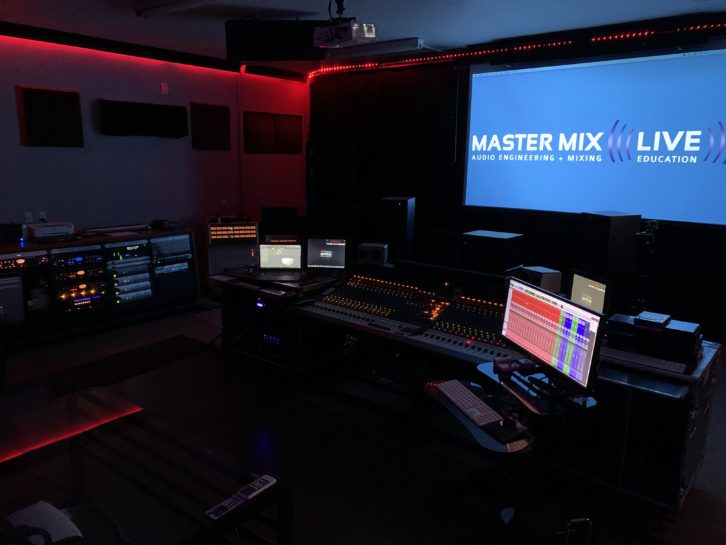
For the overhead channels Camp installed Tectonic PL-11 distributed-mode, flat-panel speakers, another P.A. product. “I needed something small that sounds good. I dialed them in with Smaart and they work great,” he says. “The ribbon tweeters are nice and smooth.”
Camp started out with Dolby Atmos Production Suite and Pro Tools on the same computer, but a few months ago upgraded to run Mastering Suite on a separate machine. While there are other, perhaps more popular, choices for managing Dolby Atmos signal routing and speaker management, Camp elected to install a DirectOut Technologies Prodigy MP multifunction processor. “It does multiple things: 128 channels of Ravenna, 64 channels of MADI, 64 channels of Dante and 32 channels of analog I/O-slash-mic pre’s. The box is amazing,” he says.
“I had done a project for Bally’s 10 years ago when they revamped their system for Jubilee, the longest-running strip show in Vegas,” he recalls. “I redid the sound system and used a DirectOut MADI A/D converter to switch between two computers.” When the company introduced the Prodigy MP, he jumped on it.
Signal transport in his room is via several protocols, with 64 channels out of Pro Tools passing through an SSL XLogic MADI converter into the Prodigy, which sends a Dante stream to his Mastering Suite computer. The computer feeds Dante back into the Prodigy, which outputs analog sends to the separate 7.1.4 Dolby Atmos and 7.1 surround monitor systems.
With everything installed, Camp set up a test with DirectOut’s Luca Giaroli to see if he could do remote real-time mixing out of his room. Giaroli, at the headquarters of Vivivaldy, a long-distance real-time synchronized audio transmission solutions developer in Milan, played out a multitrack session that Camp had previously sent him. A custom Vivivaldy VPN switch was installed at each end and a maximum buffer size of 32,768 samples (or 682.67 ms) set to avoid packet loss of the 48k audio. Camp’s PTP-enabled Sonifex AVN-GMC Grandmaster Clock provided sub-microsecond synchronization via GPS satellite.
The results were everything that Camp had hoped for, even with a reported 32 switch hops in the path and using his regular Internet service provider, which offers a 200 Mbps download speed with 20 Mbps on the upload. “I brought everything into Pro Tools, recorded it, and while I was recording it, I was mixing it live back to Luca in stereo and 7.1.4, in under two seconds,” he says.
“I’m always looking for the newest, latest, greatest thing,” he concludes. “But I don’t just jump on anything; I had to be convinced.” This time, the proof was in the streaming.
